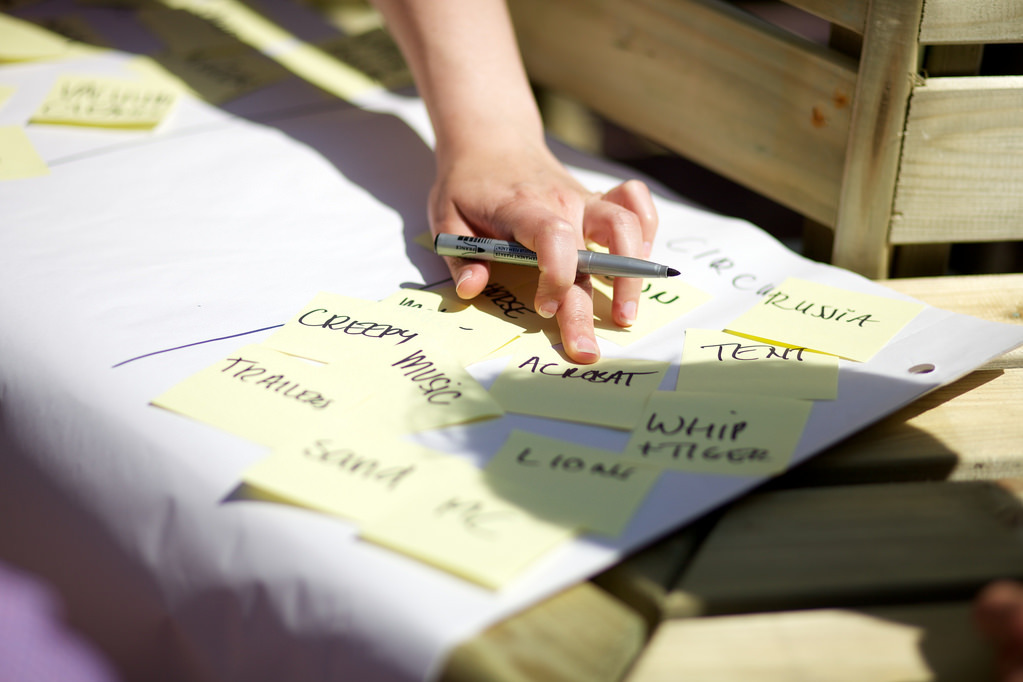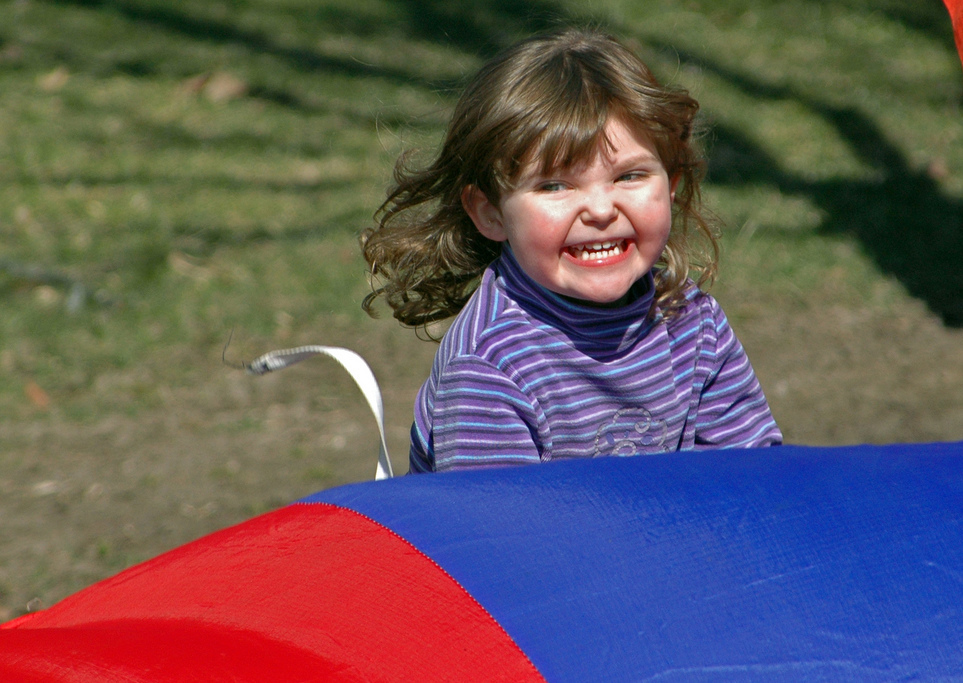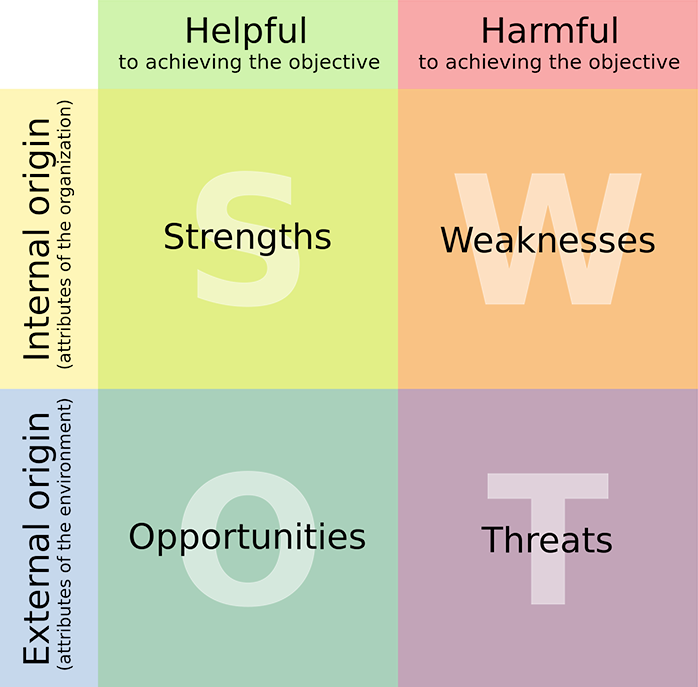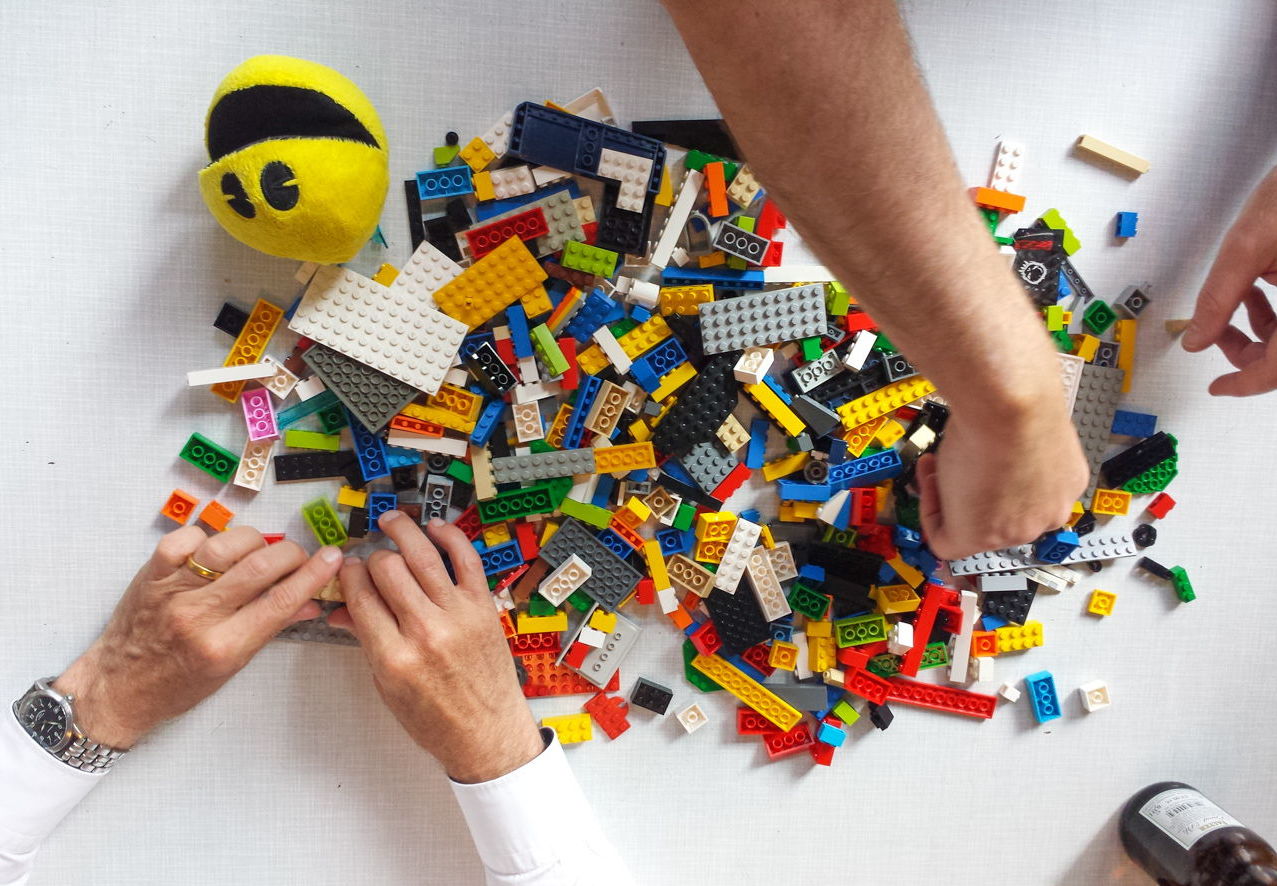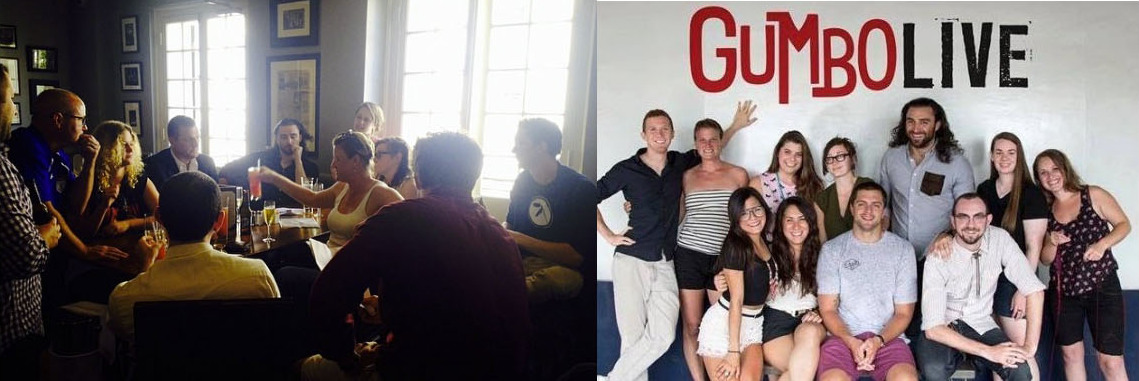Creative Thinking
Why Collaborative Games Are the Future of Brainstorming Techniques (And How to Use Them)
By Renata Mann on August 30, 2016
"Bananas!" Alex yells through the arguing voices. Our ragtag team suddenly stops their chatter. "We aren't getting anywhere," Alex announces. "We need a game of Monster." Some of us groan, some jump out of our seats, and we all file out to the expansive deck overlooking the heart of the French Quarter of New Orleans.
The riverboat's horn lets out a shrill squeal, and the sound of a passing parade drifts into the distance. Our group of "Change Agents" begins shuffling around the deck in a circle, making strange awkward movements and expressive squawking sounds. We look like angry predator birds.
It may be surprising that this scene occurred in a workplace, but this is what a typical day looked like when I worked at GumboLive-a small marketing and innovation think tank in New Orleans. Silly as it seems, there was a purpose behind the bizarre scene on the deck. Games and rituals helped manage our focus and productivity. GumboLive was founded on the premise that great ideas can come from anywhere, and the belief that collaboration between diverse perspectives produces the most innovative results. When people work together harmoniously for a collective purpose, the solution that emerges is more than any one person could have imagined alone. But successful collaboration doesn't just happen. Games make collaboration consistently successful, and they help get us to the solution faster. Game processes can revolutionize the way we work together, build creative culture, and drive innovation.
I believed the theory behind the think tank, and was excited to test it. I have experienced the power of harmonious collaboration, a collective syncing, and the rush of energy it brings. My first memory of the phenomenon was during a field day in early elementary school. Collaboration was surely thriving in the field that day, with relay races, capture the flag, and double dutch-but for me, it was all about the giant parachute.
I loved watching the waves ripple through the huge piece of fabric as everyone grabbed hold. In my mind, it was the largest piece of fabric in existence. The ultimate goal was to catch enough air to create an air pocket large enough to sit in. The whole group had to work in perfect harmony, build up momentum in a synchronized rhythm, then slide in under the edge simultaneously. Inside the cloud, it was beautiful, calming, and satisfying. Sitting in that parachute cloud room was so special because it was only possible if everyone collaborated successfully.
There is tremendous value in collaboration when it actually works. Companies that can unlock the creative power of collaboration get more efficiency, more innovation, and happier, more dedicated employees. Everyone knows they should be collaborating, but few do it right.
When I started at the think tank, I expected collaboration to feel like the parachute game: chaotic at first, but once we got going, the breakthrough moment was inevitable. In reality, successful collaboration is not so simple. When we sat down to brainstorm without a plan, it was chaos. Chaos, emotions, steadfast beliefs, fears, judgment, defense mechanisms, confusion, lack of patience, lack of empathy, egos, more egos, and a few more egos. Strong opinions, conflicting viewpoints, and different beliefs about the nature of the world plagued us. Even stronger opinions came into play on how we should get to the solution. Some people wanted to talk through everything, which drove others insane. Some wanted structure, while some thought going to a bar and getting drunk together would yield the best results. People cried, yelled, and stormed out on a weekly basis. The question quickly became: Is collaboration really a better method? And, if so, how do we do it right?
Successful Collaboration Takes Practice and Experimentation
Every company is made up of many people, and even individual practitioners interact with and rely on others frequently. On the subject of problem solving and idea generation in business, the question has always been, "How do we make the most of our combined brain power in the time we have?"
In 1970s Silicon Valley, people explored this question and experimented with possible solutions. Workplace rituals and games started to emerge, and as they spread through businesses, they were improved upon and refined. Dave Gray and Sunni Brown collected many of these tried and true games into a book called Gamestorming: A Playbook for Innovators, Rulebreakers, and Changemakers. One of the most well-known examples of a collaboration game is SWOT, a process which analyzes the strengths, weaknesses, opportunities, and threats of a subject or situation.
Game processes for collaboration have been used to great success by Google, Apple, AirBnB, IDEO, Tesla, and others. LEGO even partnered with management consultants to create LEGO Serious Play, a problem solving and ideation process involving LEGO bricks that is used by forward-thinking organizations around the world. Researchers are exploring the connection between inspiration and the collaborative flow state that jazz musicians experience while playing together. Game processes can bring the power of design thinking to any company, in any industry. They foster a creative, collaborative culture in which innovative solutions drive business transformation.
During my time at the think tank, we explored many brainstorming techniques: purely conversational, sitting on the floor passing a talking stick, yelling over each other at bars, endlessly restating the problem, arguing until no one cared, and simply going with the loudest voice. We discovered collaborative game processes and tried them out, altering and reinventing them to suit our needs. Several team members took improv classes in the evenings. We went to see their performances and adapted the improv games to work for us in the office. Through improv we learned how to truly support each other, stay positive, and overcome fears.
When we used games in our creative process, we did our best work, were most productive, had the most fun, and got the most out of it. That was when we were in sync with one another and ourselves. Through trial and error we realized what worked best for us, eventually developing a collection of methods and tools. Rituals and games helped us sustain energy and focus throughout a day of collaborating. The game Monster was used often to redirect energy, get emotions out, and shift focus for five minutes. We used improv games, writing games, imagination games, board games, and refashioned drinking games. Of course, it never hurt to have an incredible office space to spark creativity.
ProTip: If You Can Do It Through Email, It's Not a Brainstorm
When I joined Skyword as the sole creative strategist, there was a creativity crisis. Creative thinking and creative problem solving are essential to the quality of our work and our company's long-term success, but few employees think of themselves as creative-let alone as creative collaborators. Teams meet often to come up with topic ideas for content marketing programs, but a typical brainstorm session involved sitting around a table, with one person leading, while everyone else tried to pull ideas out of the air. This is an all-too-common scene at many workplaces. The biggest problem with these so-called brainstorms is that they make an impossible request: they ask ideas to flow on command. While it may be possible to struggle through a brainstorm this way, it is an inefficient use of group time and at best yields status quo, base-level results.
Bringing games into topic brainstorms has transformed the feeling and the output of our collaborative sessions. Within a few months, my coworkers started walking into game sessions saying things like, "It always feels like a breath of fresh air!" After a recent brainstorm session a client said, "I can't believe something so fun works so well!" Game sessions inspire passion and enthusiasm for doing the work. We become fully immersed in the task, forget where we are, and lose track of time. People leave the room buzzing with excitement. When was the last time you felt like that at work?
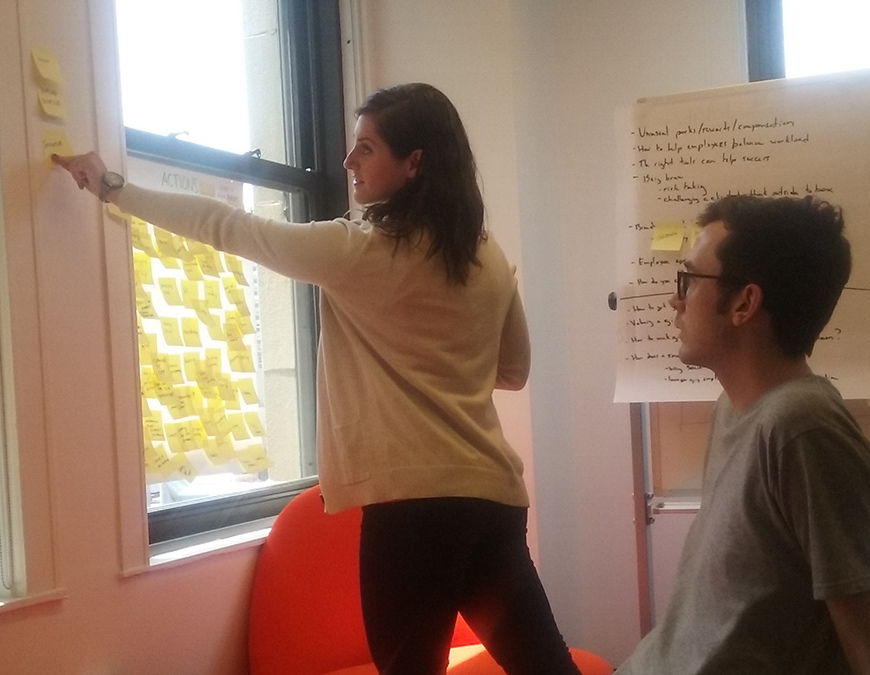
These processes work so well because they prevent common barriers to successful collaboration. Games require equal participation, so everyone gets a voice and creates objective ways to judge the merit of ideas quickly. Games have a beginning, middle, and end, which keeps the group on track to reach the end goal, while time restraints increase focus and the desire to succeed. Games free up our minds for creative and critical thinking by storing information in the environment around us. Collaborative games for the workplace use materials found in every office. Conference rooms become the game world, whiteboards serve as game boards, and sticky notes become game pieces that move through the game world, gathering new meaning.
Collaboration games provide the structure for creativity to thrive, while simultaneously managing it. Games create safe spaces to take risks, and leave no room for destructive egos. They stop habitual thinking and prevent the dreaded groupthink. These processes are designed to generate unexpected inputs and comparisons, therefore providing endless ways of seeing something, and from new perspective comes new insight. New insight leads to new ideas and innovative solutions.
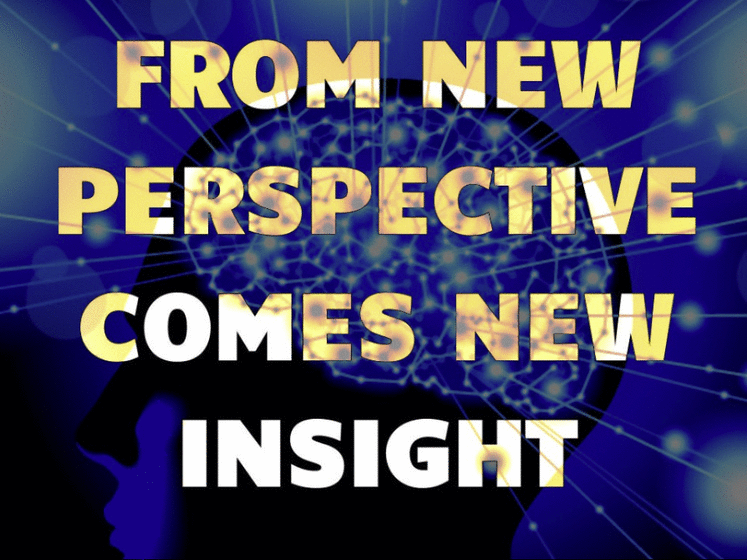
Collaboration Games Work for Everyone-Even Your Clients and Your Boss
One of our clients challenged our team to elevate the quality of their next in-person topic brainstorm. Topics for the somewhat dry, industry-focused content program were getting harder and harder to come up with. Our team would rack their brains trying to put new spins on the same basic stories, asking, "Have we done something like this yet?" Whatever we brought to the table for this brainstorm, we had to wow them.
We arrived at the extremely clean corporate office park, walked into a conference room of senior leaders, and unrolled an idea generation game I call Actors and Artifacts. It is a simple process: break down the world of your subject matter into all of its components, then fuse the parts into random combinations that spark new and unexpected ideas. At first, people in the room seemed to fluctuate between excited to be playing a game, and skeptical of its ability to produce results. As time went on, everyone became immersed and engaged in the process. The CMO actually tried to outsmart the game, creating an especially difficult combination of inputs, but the group found new ways of seeing the problem, and came up with great ideas as a result. Everyone in the room that day had fun, saw the process working, and loved the fresh ideas. The health of our client relationship increased, and a new level of mutual trust was achieved.
Collaborative games are easy to integrate into your brainstorming techniques. If you get pushback from senior leadership, invite (aka dare) them to attend one of the game sessions to experience the effectiveness themselves. If your team members want to give up before they start because they don't understand the method or it feels unfamiliar, urge them to try it with open minds. The process works when people embrace it.
Download my Facilitation Guide for in-depth instructions on hosting an Empathy Mapping session, a widely applicable collaborative game process.
Additional resources and places to explore:
